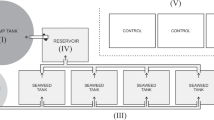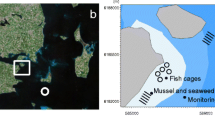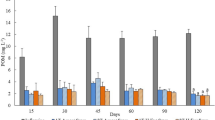Abstract
The potential of rearing the red seaweed Mastocarpus stellatus (Stackhouse) Guiry, a carrageenophyte, as a biofilter in a pilot-scale, integrated multi-trophic aquaculture (IMTA) system was investigated. From April to June, M. stellatus, collected from a population in the north of Portugal was cultivated in 1200-L tanks in two consecutive, 4-week experiments with nutrient-enriched waters derived from fish tanks. The stocking density of 3 kg m−2 provided the best yields, ranging from 29.6 g dw m−2 day−1 in April–May to 38.9 g dw m−2 day−1 in June. In the April–May period, a linear increase in the yields was found at higher densities. M. stellatus growth rates during April–May period did not diverge significantly between stocking densities and reached a mean relative growth rate of 3.09 ± 0.90 % day−1 in April–May and 4.02 ± 0.43 % day−1 in June at 3 kg m−2. In June, the increase in stocking density negatively affected the growth rates (3 < 2 < 1 kg m−2). M. stellatus used ammonium (TAN) as the main N source and the nutrient uptake efficiency was found to be similar between stocking densities, but highest in June. The seaweeds removed an average of 66.29 ± 3.57 μmol TAN L–1 in May and 84.49 ± 4.00 μmol TAN L–1 in June, which corresponded to the mitigation of 43.19 ± 1.61 and 49.00 ± 1.59 % of NH3 from the system, respectively. This study demonstrated the potential to effectively cultivate M. stellatus in an IMTA system.

Similar content being viewed by others
References
Abreu MH, Pereira R, Yarish C, Buschmann AH, Sousa-Pinto I (2011) IMTA with Gracilaria vermiculophylla: productivity and nutrient removal performance of the seaweed in a land-based pilot scale system. Aquaculture 312:77–87
Araújo R, Bárbara I, Tibaldo M, Berecibar E, Tapia PD, Pereira R, Santos R, Sousa-Pinto I (2009) Checklist of benthic marine algae and cyanobacteria of northern Portugal. Bot Mar 52:24–46
Bixler HJ, Porse H (2011) A decade of change in the seaweed hydrocolloids industry. J Appl Phycol 23:321–335
Buschmann AH, Troell M, Kautsky N, Kautsky L (1996) Integrated tank cultivation of salmonids and Gracilaria chilensis (Gracilariales, Rhodophyta). Hydrobiologia 326:75–82
Buschmann AH, Hernández-González MC, Aranda C, Chopin T, Neori A, Halling C, Troell M (2008) Mariculture Waste Management. Ecol Eng 3:2211–2217
Chopin T, Buschmann AH, Halling C, Troell M, Kautsky N, Neori A, Kraemer GP, Zertuche-Gonzalez JA, Yarish C, Neefus C (2001) Integrating seaweeds into marine aquaculture systems: a key toward sustainability. J Phycol 37:975–986
Chopin T, Robinson SMC, Troell M, Neori A, Buschmann AH, Fang J (2008) Multitrophic integration for sustainable marine aquaculture. In: Jørgensen SE, Fath BD (eds) Ecol Eng, Vol. 3 of Encyclopedia of Ecology, Vol. 5. Elsevier, Oxford, pp 2463–2475
Corey P, Kim JK, Duston J, Garbary DJ, Prithiviraj B (2013) Bioremediation potential of Palmaria palmata and Chondrus crispus (Basin Head): effect of nitrate and ammonium ratio as nitrogen source on nutrient removal. J Appl Phycol 25:1349–1358
Crab R, Avnimelech Y, Defoirdt T, Bossier P, Verstraete W (2007) Nitrogen removal techniques in aquaculture for a sustainable production. Aquaculture 270:1–14
Dudgeon SR, Kübler JE, Vadas RL, Davison IR (1995) Physiological responses to environmental variation in intertidal red algae: does thallus morphology matter? Mar Ecol Prog Ser 117:193–206
Guiry MD, West JA (1983) Life history and hybridization studies on Gigartina stellata and Petrocelis cruenta (Rhodophyta) in the North Atlantic. J Phycol 19:474–494
Hayashi L, Yokoya NS, Ostini S, Pereira RTL, Braga ES, Oliveira EC (2008) Nutrients removed by Kappaphycus alvarezii (Rhodophyta, Solieriaceae) in integrated cultivation with fishes in re-circulating water. Aquaculture 277:185–191
Hernández I, Martínez-Aragón JF, Tovar A, Pérez-Lloréns JL, Vergara JJ (2002) Biofiltering efficiency in removal of dissolved nutrients by three species of estuarine macroalgae cultivated with sea bass (Dicentrarchus labrax) waste waters 2. Ammonium. J Appl Phycol 14:375-384 Hernández I, Pérez-Pastor A, Vergara JJ, Martínez-Aragón J, Fernández-Engo M, Pérez-Lloréns JL (2006) Studies on the biofiltration capacity of Gracilariopsis longissima: from microscale to macroscale. Aquaculture 252:43–53
Hilliou L, Larotonda FDS, Abreu P, Ramos AM, Sereno AM, Gonçalves MP (2006) Effect of extraction parameters on the chemical structure and gel properties of k/i-hybrid carrageenans obtained from Mastocarpus stellatus. Biomol Eng 23:201–208
Islam SM, Tanaka M (2004) Impacts of pollution on coastal and marine ecosystems including coastal and marine fisheries and approach for management: a review and synthesis. Mar Pollut Bull 48:624–649
Kautsky N, Troell M, Folke C (1997) Ecological engineering for increased production and environmental improvement in open sea aquaculture. In: Ethnier C, Guterstam C (eds) Ecological Engineering for Waste Water Treatment, 2nd edn. Lewis Publishers, Chelsea, pp 387–393
Kim JK, Duston J, Corey P, Garbary DJ (2013) Marine finfish effluent bioremediation: effects of stocking density and temperature on nitrogen removal capacity of Chondrus crispus and Palmaria palmata (Rhodophyta). Aquaculture 414-415:210–216
Lahaye M (2001) Developments on gelling algal galactans, their structure and physico-chemistry. J Appl Phycol 13:173–184
Larotonda F (2007) Biodegradable films and coatings obtained from carrageenan from Mastocarpus stellatus and starch from Quercus suber. PhD thesis. University of Porto, pp 315
Lobban CS, Harrison PJ (1994) Seaweed ecology and physiology. Cambridge University Press, Cambridge, p 366
Lohrmann NL, Logan BA, Johnson AS (2004) Seasonal acclimatization of antioxidants and photosynthesis in Chondrus crispus and Mastocarpus stellatus, two co-occurring red algae with differing stress tolerances. Biol Bull 207:225–232
Mata L, Santos R (2003) Cultivation of Ulva rotundata (Ulvales, Chlorophyta) in raceways using semi-intensive fishpond effluents: yield and biofiltration. In: Chapman AR, Anderson RJ, Vreeland VJ, Davison IR (eds) Proceedings of the 17th International Seaweed Symposium, Cape Town 2001. Oxford University Press, Oxford, pp 237–242
Mata L, Schuenhoff A, Santos R (2010) A direct comparison of the performance of the seaweed biofilters, Asparagopsis armata and Ulva rigida. J Appl Phycol 22:639–644
Matos J, Costa S, Rodrigues A, Pereira R, Sousa-Pinto I (2006) Experimental integrated aquaculture of fish and red seaweeds in Northern Portugal. Aquaculture 252:31–42
McHugh DJ (2003) A guide to the seaweed industry. FAO Fisheries Technical Paper 441, Food and Agriculture Organization of the United Nations, Rome, pp. 118
Naylor RL, Goldburg RJ, Primavera JH, Kautsky N, Beveridge MCM, Clay J, Folke C, Lubchenco J, Mooney H, Troell M (2000) Effect of aquaculture on world fish supplies. Nature 405:1017–1024
Neori A, Shpigel M (1999) Using algae to treat effluents and feed invertebrates in sustainable integrated mariculture. World Aquacult 30:46–51
Neori A, Chopin T, Troell M, Buschmann AH, Kraemer GP, Halling C, Shpigel M, Yarish C (2004) Integrated aquaculture: rationale, evolution and state of the art emphasizing seaweed biofiltration in modern mariculture. Aquaculture 231:361-391
Official Journal of the European Union (2000) Directive 2000/60/EC of the European Parliament and of the Council establishing a framework for the Community action in the field of water policy. 327:1-73
Official Journal of the European Union (2009) Commission regulation 710/2009 of 5 August 2009. 204:15-33
Páez-Osuna F, Guerrero-Galván SR, Ruiz-Fernández AC (1998) The environmental impact of shrimp aquaculture and the coastal pollution in Mexico. Mar Pollut Bull 36:65–75
Pereira L, Mesquita JF (2003) Carrageenophytes of occidental Portuguese coast: 1-spectroscopic analysis in eight carrageenophytes from Buarcos bay. Biomol Eng 20:217–222
Pereira L (2013) Population studies and carrageenan properties in eight Gigartinales (Rhodophyta) from Western coast of Portugal. Sci World J. doi:10.1155/2013/939830
Pereira R, Kraemer G, Yarish C, Sousa-Pinto I (2008) Nitrogen uptake by gametophytes of Porphyra dioica (Bangiales, Rhodophyta) under controlled-culture conditions. Eur J Phycol 43:107-118Picullel L (1995) Gelling carrageenans. In: Stephen AM (ed) Food polysaccharides and their applications. Marcel Dekker, New York, pp 205–244
Portuguese Institute for Ocean and Atmosphere (2010). Monthly climatological bulletin. http://www.ipma.pt. Accessed 2 August 2013
Read P, Fernandes T (2003) Management of environmental impacts of marine aquaculture in Europe. Aquaculture 226:139–163
Robertson-Andersson DV (2003) The cultivation of Ulva lactuca (Chlorophyta) in an integrated aquaculture system, for the production of abalone feed and the bioremediation of aquaculture effluent. MSc Dissertation, University of Cape Town, South Africa
Schramm W, Lotze HK, Schories D (1996) Eutrophication and macroalgal blooms in inshore waters of the German Baltic coast: The Schlei Fjord, a case study. EUMAC Synthesis rep., Netherlands Institute of Ecology (NIOOKNAW): 17-73
Schuenhoff A, Shpigel M, Lupatsch I, Ashkenazi A, Msuya FE, Neori A (2003) A semi-recirculating, integrated system for the culture of fish and seaweed. Aquaculture 221:167–181
Skalar (2004) The San Plus Continuous Flow Analyzer e User Manual: Section 8 e Operating the SFA Analyzer. Skalar Analytical BV, DE Breda, Netherlands
South GR, Tittley I (1986) A checklist and distributional index of the benthic marine algae of the North Atlantic Ocean. British Museum (Natural History), London, pp 76
Tacon AGJ, Phillips MJ, Barg UC (1995) Aquaculture feeds and the environment: the Asian experience. Water Sci Technol 31:41–59
Tasende MG, Rodríguez González LM (2003) Economic seaweeds of Galicia (NW Spain). Thalassas 19:17–25
Tasende MG, Cid M, Fraga MI (2013) Qualitative and quantitative analysis of carrageenan content in gametophytes of Mastocarpus stellatus (Stackhouse) Guiry along Galician coast (NW Spain). J Appl Phycol 25:587–596
Troell M, Halling C, Nilsson A, Buschmann AH, Kautsky N, Kautsky L (1997) Integrated marine cultivation of Gracilaria chilensis (Gracilariales, Rhodophyta) and salmon cages for reduced environmental impact and increased economic output. Aquaculture 156:45–61
Troell M, Halling C, Neori A, Chopin T, Buschmann AH, Kautsky N, Yarish C (2003) Integrated mariculture: asking the right questions. Aquaculture 226:69–90
Van de Velde F, Knutsen SH, Usov AI, Rollema HS, Cerezo AS (2002) 1H and 13C high resolution NMR spectroscopy of carrageenans: application in research and industry. Trends Food Sci Technol 13:73–92
Zhou Y, Yang H, Hu H, Liu Y, Mao Y, Zhou H, Zhang F (2006) Bioremediation potential of the macroalga Gracilaria lemaneiformis (Rhodophyta) integrated into fed fish culture in coastal waters of north China. Aquaculture 252:264–276
Acknowledgments
The authors acknowledge the help in all the field work given by Tiago Santos and the availability of the aquaculture company A. Coelho & Castro, Lda for the IMTA studies. This work was supported by FEDER funds through the program COMPETE (project PTDC/CTM/100076/2008).
Author information
Authors and Affiliations
Corresponding author
Rights and permissions
About this article
Cite this article
Domingues, B., Abreu, M.H. & Sousa-Pinto, I. On the bioremediation efficiency of Mastocarpus stellatus (Stackhouse) Guiry, in an integrated multi-trophic aquaculture system. J Appl Phycol 27, 1289–1295 (2015). https://doi.org/10.1007/s10811-014-0414-3
Received:
Revised:
Accepted:
Published:
Issue Date:
DOI: https://doi.org/10.1007/s10811-014-0414-3




